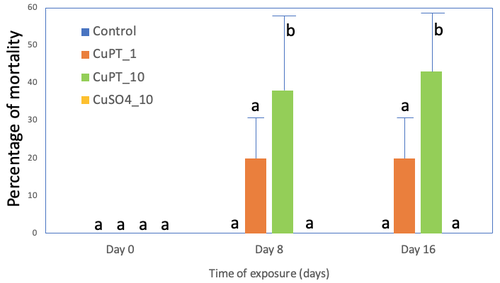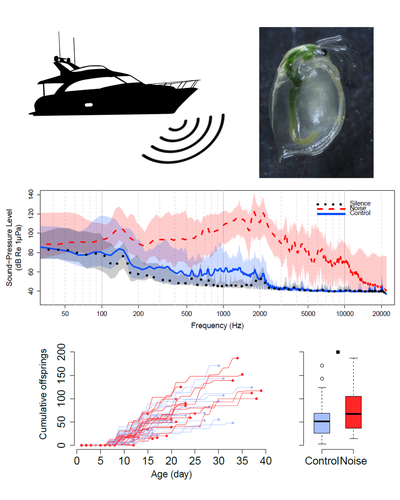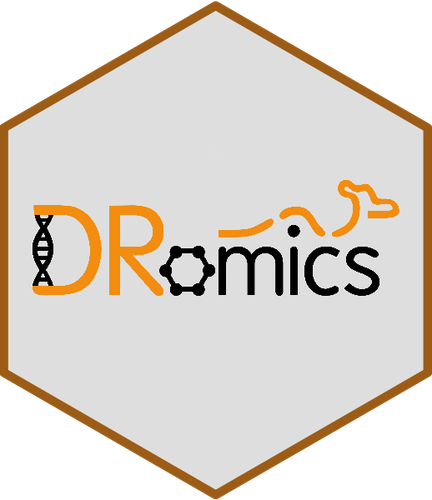Recommendations: 3

Characterization of the bioaccumulation and toxicity of copper pyrithione, an antifouling compound, on juveniles of rainbow trout
Bioaccumulation and impact of copper pyrithione impact in juveniles of rainbow trout
Recommended by Claudia Cosio based on reviews by Anne-Sophie Voisin and 1 anonymous reviewerOur ability to anticipate and estimate how pollution affects biota is intrumental in the field of ecotoxicology. Impact of chemical pollution by metals, drugs or pesticides was widely studied in different species using acute and chronic scenarios. Since the ban on tributyltin in antifouling paints, other copper (Cu)-based paints are on the market, including a new generation of booster biocides:metal pyrithiones such as Cu pyrithione (CuPT). Pyrithione acts as a Cu ionophore facilitating Cu transport across the membranes. Although some data show their occurrence in aquatic ecosystems and few studies on the toxicity of CuPT in fish are published, major gaps in knowledge remain about their toxicity and toxic pathway. Few studies were previously conducted in animals exposed to CuPT pointing to reprotoxicity, developmental malformation and mortality (Li et al. 2021, Mochida et al., 2011; Mohamat-Yusuff et al., 2018, Shin et al., 2022). However, its toxicokinetic and toxicodynamic remain to be characterized in details.
In this context, Bourdon et al. (2023) compared in juveniles of rainbow trout (Oncorhynchus mykiss), the effects of exposure to CuPT and ionic Cu2+ at equivalent Cu2+ molar concentrations. Presented data allow to compare the toxicity threshold, the accumulation of Cu and mechanisms of toxicity of both compounds. Acute and chronic exposures showed a higher bioaccumulation of Cu in the gills, and a higher toxicity of CuPT than that of ionic Cu2+, e.g. mortality , transcription levels of genes related to oxidative stress, detoxification and Cu transport. Intriguingly, the activities of enzymatic biomarkers used as proxy of antioxidant capacity were not significantly altered, although Cu is generally expected to trigger oxidative stress. In conlusion, this study brings new knowledge pointing that the presence of CuPT in the environment could induce toxic effects in non-target species. Moreover, it support the need to study in detail the toxicity of Cu-based paints to adapt regulations concerning their use and release in aquatic environments. Because of its low solubility in water, CuPT is expected to adsorb to suspended matter and food pellets. Future research should study this route of exposure.
References
Bourdon, C., Cachot, J., Gonzalez, P., Couture, P., 2023. Characterization of the bioaccumulation and toxicity of copper pyrithione, an antifouling compound, on juveniles of rainbow trout, bioRxiv ver. 3 peer-reviewed and recommended by Peer Community in Ecotoxicology and Environmental Chemistry. https://doi.org/10.1101/2023.01.31.526498
Li, X., S. Ru, H. Tian, S. Zhang, Z. Lin, M. Gao and J. Wang, 2021. Combined exposure to environmentally relevant copper and 2,2′-dithiobis-pyridine induces significant reproductive toxicity in male guppy (Poecilia reticulata). Science of the Total Environment 797, https://doi.org/10.1016/j.scitotenv.2021.149131
Mochida, K., Amano, H., Onduka, T., Kakuno, A., Fujii, K., 2011. Toxicity and metabolism of copper pyrithione and its degradation product, 2,2’-dipyridyldisulfide in a marine polychaete. Chemosphere 82, 390–397, https://doi.org/10.1016/j.chemosphere.2010.09.074
Mohamat-Yusuff, F., Sarah-Nabila, Ab.G., Zulkifli, S.Z., Azmai, M.N.A., Ibrahim, W.N.W., Yusof, S., Ismail, A., 2018. Acute toxicity test of copper pyrithione on Javanese medaka and the behavioural stress symptoms. Marine Pollution Bulletin 127, 150–153, https://doi.org/10.1016/j.marpolbul.2017.11.046
Shin, D., Y. Choi, Z. Y. Soon, M. Kim, D. J. Kim and J. H. Jung, 2022. Comparative toxicity study of waterborne two booster biocides (CuPT and ZnPT) on embryonic flounder (Paralichthys olivaceus). Ecotoxicology and Environmental Safety 233, https://doi.org/10.1016/j.ecoenv.2022.113337

No evidence for an effect of chronic boat noise on the fitness of reared water fleas
Noise impact in Daphnia magna
Recommended by Claudia Cosio based on reviews by Marie-Agnès Coutellec and 1 anonymous reviewerOur ability to anticipate and estimate how pollution affects biota is of paramount importance in the field of ecotoxicology. Impact of chemical pollution by metals, drugs or pesticides was widely studied in different species using acute and chronic scenarios. While environmental factors such as temperature are also often considered, noise is largely ignored in these models despite the knowledge of its detrimental effects in vertebrates. Studies of noise impacts included behavior and fitness endpoints and showed no effect to death depending on intensity, frequency and the distance from the noise source (Peng et al., 2015). Nonetheless, the impact of noise in biota is not well-understood, which impairs its effective mitigation.
Noise or acoustic pollution due to boat traffic produce low-frequency stationary noise. It is a pervasive and ubiquitous pollutant found in aquatic ecosystems. In this context, Prosnier et al. (2023) addresses how intermittent and random noise impacted Daphnia magna, a representative of zooplankton model, widely used in ecotoxicology. Endpoints of lifespan and clonal offspring production were measured in the presence or absence of motorboat noises, in animals reared from birth to death. Noise consisted in a playlist of 15 sounds of motorboat recorded in the Grangent lake (Loire, France). Their intensity ranged from 0 to -25 dB Re 1 μPa by 5 dB to create 75 sounds from 103 to 150 dB RMS Re 1 μPa – a range of levels occurring in lakes. Treatment had no effect on analyzed endpoints, contrary to a continuous broadband noise (100-20,000 Hz) that caused higher survival and fecundity, and reduced speed of motion compared to control (Prosnier et al., 2022). Data point that temporal (continuous, regular, random) and frequency of noise are instrumental for its effects.
References
Peng, C., X. Zhao and G. Liu (2015). "Noise in the Sea and Its Impacts on Marine Organisms." Int J Environ Res Public Health 12(10): 12304-12323. https://doi.org/10.3390/ijerph121012304
Prosnier, L., E. Rojas and V. Médoc (2023). "No evidence for an effect of chronic boat noise on the fitness of reared water fleas." bioRxiv: 2022. ver. 4 peer-reviewed and recommended by Peer Community in Ecotoxicology and Environmental Chemistry. https://doi.org/10.1101/2022.11.20.517267
Prosnier, L., E. Rojas, O. Valéro and V. Médoc (2022). "Chronic noise unexpectedly increases fitness of a freshwater zooplankton." bioRxiv: 2022. https://doi.org/10.1101/2022.11.19.517212

DRomics, a workflow to exploit dose-response omics data in ecotoxicology
New features of DRomics workflow for improved analyze of dose-response omics data in ecotoxicology
Recommended by Claudia Cosio based on reviews by Jean Armengaud, Beatrice Gagnaire and Rebecca BeauvaisOur ability to anticipate and estimate how pollution affects components of ecosystems is of paramount importance in the field of ecotoxicology. Dose-response modeling is instrumental, as it allows deriving sensitivity thresholds used at the basis of regulatory risk assessment. In recent years, omics have highly influenced how the impacts of stressors are understood by revealing molecular changes at all levels of biota biological organization (Ebner et al., 2021). To allow analysis of omics data obtained using a typical dose-response design, DRomics a freely available tool for dose-response was proposed composed of both an R package and a free web application (Larras et al. 2018). Advances in this field depend both on theoretical concepts, technology and data integration.
In this context, Delignette-Muller et al. (2023) address the question of how to better integrate omics information in dose-response questions. The paper lists previous possibilities of DRomics and presents new features. It is now able to handle all types of continuous omic and continuous non-omic data (e.g. growth data). This new version proposes new visualization tools, functional annotation and improved modeling workflow for a better robustness of analysis of data with few replicates. New features are meant to help for biological interpretation at the metabolic pathway level, to compare different measurements, biological materials or experimental settings.
References
Delignette-Muller, M. L., A. Siberchicot, F. Larras and E. Billoir (2023), DRomics, a workflow to exploit dose-response omics data in ecotoxicology. bioRxiv, 2023.2002.2009.527852, ver. 4 peer-reviewed and recommended by Peer Community in Ecotoxicology and Environmental Chemistry. https://doi.org/10.1101/2023.02.09.527852
Ebner JN. (2021) Trends in the Application of "Omics" to Ecotoxicology and Stress Ecology. Genes, 12(10):1481. https://doi.org/10.3390/genes12101481
Larras F, Billoir E, Baillard V, Siberchicot A, Scholz S, Wubet T, Tarkka M, Schmitt-Jansen M and Delignette-Muller ML (2018). DRomics: a turnkey tool to support the use of the dose-response framework for omics data in ecological risk assessment. Environmental science & technology, 52(24):14461. https://doi.org/10.1021/acs.est.8b04752

